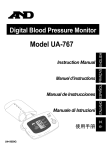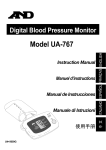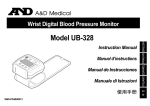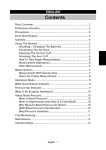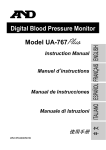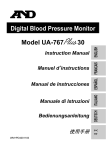Download A&D UA-767PC Instruction manual
Transcript
Digital Blood Pressure Monitor Model UA-767 Instruction Manual Manuel d’instructions Manual de Instrucciones Manuale di Istruzioni U4+5659G ENGLISH Dear Customers Congratulations. You have purchased an A&D blood pressure monitor, one of the most technologically advanced, yet easy to use products available in the marketplace today. We strongly recommend you read this instruction manual carefully prior to using it the first time. General Information This device conforms to the European Directive 93/42/EEC for Medical Products. This is evidenced by the mark of conformity (0366: The reference number of a designated authority). This device is designed for monitoring your blood pressure and pulse rate at home. Therefore, intended use of this device is limited to monitoring blood pressure and pulse for the general public, except newborns and infants. Note 1. This device is designed for personal use and not for public use. 2. This device is not designed for measuring newborns or infants. Using this device on newborns and infants could cause injury to the child. DO NOT USE on newborns or infants. Precautions 1. Precision components were used in the construction of this device. Extremes in temperature, humidity, direct sunlight, shock or dust should be avoided. 2. Clean the device with a dry, soft cloth. Never use thinner, alcohol, benzine, or wet dusters. 3. Avoid folding the cuff tightly or storing the hose tightly twisted for long periods, as such treatment may shorten the life of the components. 4. The device and cuff are not water resistant. Protect the device and cuff from rain, sweat and water. 5. Measurements may be impaired if the device is used close to televisions, microwave ovens, cellular telephones, X-ray or other devices with strong electrical fields. 6. Used equipment, parts and batteries are not treated as ordinary household waste, and must be disposed of according to the applicable regulations ENGLISH 1 Parts Identification ENGLISH 2 Symbols Symbols SN Function / Meaning Treatment Turns the device on and off. ___________ Guide to install battery ___________ Direct current ___________ Serial number ___________ Date of manufacture ___________ Type BF: Device, cuff and tubing are designed to provide special protection against electrical shocks. ___________ Appears when measurement is Measurement is in progress in progress and flashes when the - remain still. pulse is detected. Appears when the battery voltage Replace all batteries with is too low for the device to work new ones. properly. Verify that the air hose is Appears if the systolic and diastolic properly connected and that measurements are within 10 the exhaust rate is between mmHg of each other. 2 and 5 mmHg. Check for air leaks. Appears if the pressure value is Try the measurement again. unstable due to movement during Remain very still during the the measurement. measurement. Verify that the air hose is Appears if the pressure value properly connected and that does not increase during the exhaust rate is between 2 and 5 mmHg. inflation. Check for air leaks. Pulse beats per minute ___________ The medical device label by the EC directive ___________ WEEE label ___________ ENGLISH 3 Using the Monitor 1. Installing / changing the batteries Remove the battery cover and insert new batteries into the battery compartment as shown, taking care that the polarities (+) and (-) are observed. Use only R6P, LR6, AA or similar type batteries. • Insert the batteries as shown in the battery compartment. If not, the device will not work. • When (LOW BATTERY mark) appears in the display, replace all batteries with new ones at the same time. Do not mix old and new batteries. It may shorten the battery life, or cause the device to malfunction. • (LOW BATTERY mark) does not appear when the batteries are drained. • Battery life varies with the ambient temperature and may be shorter at low temperatures. • Remove the batteries if the device is not to be used for a long period of time. The batteries may leak and cause a malfunction. • Use the specified batteries only. The batteries provided with the device are for testing monitor performance and may have a shorter life. 2. Connecting the air hose Insert the air connector plug into the air socket firmly. ENGLISH 4 Using the Monitor 3. Attaching the arm cuff Wrap the cuff around the upper arm, about 2-3 cm above the elbow, as shown. Place the cuff directly against the skin, as clothing may cause a faint pulse, and result in a measurement error. Constriction of the upper arm, caused by rolling up a shirt sleeve, may prevent accurate readings. 4. How to take proper measurements For the most accurate blood pressure measurement: • Sit comfortably at a table. Rest your arm on the table. • Relax for about five to ten minutes before measurement. • Place the center of the cuff at the same height as your heart. • Remain still and keep quiet during measurement. • Do not measure right after physical exercise or a bath. Rest twenty or thirty minutes before taking the measurement. • Try to measure your blood pressure at the same timeevery day. 5. Measurement During measurement, it is normal for the cuff to feel very tight. (Do not be alarmed). 6. After measurement After measurement, press the START button to turn off the power. Remove the cuff and record your data. Note The device has an automatic power shut-off function, which turns off the power automatically one minute after measurement. Allow at least ten minutes between measurements on the same person. ENGLISH 5 Measurements 1. Place the cuff on the arm (preferably the left arm). 2. Set the PRESSURE switch to a value that will be 30 to 40 mmHg above the expected systolic value and press the START button. • When the START button is pressed, all of the display symbols will appear for about one second. • When the " 0 " is flashing, the device is calibrating its zero point. If there is still some air in the arm cuff, it will be exhausted at this time. • The micro pump will then pressurize the cuff. Note The cuff will become very tight. This is normal. • If the START button is pressed again during pressurization or during the measurement, the pump will stop and the air will be released from the cuff. 3. When pressurization is complete, the automatic exhaust mechanism will gradually reduce the pressure in the cuff and the Measurement in Progress mark will appear along with the current pressure reading. This mark will flash in unison with the pulse of the person being monitored. ENGLISH 6 Measurements • Remain still while the device is in operation. • When a measurement is made with insufficient pressure, the device will pump again to a higher pressure. 4. When the measurement is complete, the buzzer sounds and the air is automatically released from the cuff. The systolic pressure, the diastolic pressure readings, and the pulse rate are displayed. 5. Turning the power off Press the START button to turn the power off. The device will remain in standby mode. 6. Subsequent measurements If a subsequent measurement is required, turn off the power and turn it on again. When the "0 " appears, the device is ready for another measurement. Note Allow at least ten minutes between measurements on the same person. 7. Automatic power-off function If the device is left on after a measurement, it will turn off automatically after about one minute. It may be turned off at any time by pressing the START button. ENGLISH 7 Measurements • Accurate measurement cannot be made if the exhaust velocity is outside the range of 2 to 5 mmHg. This can be determined by watching the display each time the "Measurement in Progress" mark flashes. Note the reading as the "Measurement in Progress" mark flashes. Notes for proper measurement Sit in a comfortable position. Place the arm to be used for the measurement on a table or other support so that the center of the cuff will be at the same height as your heart. • Relax for about five or ten minutes before starting a measurement. If you are excited or depressed by emotional stress, the measurement will reflect this stress as a higher (or lower) than normal blood pressure reading and the pulse reading will usually be faster than normal. • An individual’s blood pressure varies constantly, depending on what you are doing and what you have eaten. What you drink can have a very strong and rapid effect on your blood pressure. • This device bases its measurements on the heart beat. If you have a very weak or irregular heart beat, the device may have difficulty determining your blood pressure. • Should the device detect a condition that is abnormal, it will stop the measurement and display an error symbol. See the section on the descriptions of display symbols for details. • This blood pressure device is intended for use by adults only. Consult with your physician before using this device on a child. A child should not use this device unattended. ENGLISH 8 About Blood Pressure 1. What is blood pressure? Blood pressure is the force exerted by blood against the walls of the arteries. Systolic pressure occurs when the heart contracts. Diastolic pressure occurs when the heart expands. Blood pressure is measured in millimeters of mercury (mmHg). One's natural blood pressure is represented by the fundamental pressure, which is measured first thing in the morning while one is still at rest and before taking food or drink. 2. What is hypertension and how is it controlled? Hypertension is abnormally high blood pressure. If left unattended, it can cause many health problems including stroke and heart attack. Hypertension can be controlled by altering lifestyle, avoiding stress and with medication under a doctor’s supervision. To help prevent hypertension or keep it under control: • • • • • Do not smoke. Reduce salt and fat intake. Maintain proper weight. Exercise regularly. Have regular physical checkups. 3. Why measure blood pressure at home? Blood pressure measured at a clinic or doctor's office may cause apprehension or fear and can produce an elevated reading, 25 to 30 mmHg higher than that measured at home. Home measurement reduces the effects of outside influences on blood pressure readings, supplements the doctor's readings and provides a more accurate, complete blood pressure history. ENGLISH 9 About Blood Pressure 4. WHO blood pressure classification Standards for assessment of high blood pressure, without regard to age, have been established by the World Health Organization (WHO), as shown in the chart below. 5. Blood pressure variations An individual’s blood pressure varies greatly on a daily and seasonal basis. It may vary by 30 to 50 mmHg due to various conditions during the day. In hypertensive individuals, variations are even more pronounced. Normally, the blood pressure rises while at work or play and falls to its lowest levels during sleep. So, do not be overly concerned by the results of one measurement. Take measurements at the same time every day using the procedure described in this manual, and know your normal blood pressure. Multiple readings give a more comprehensive blood pressure history. Be sure to note the date and time when recording your blood pressure. Consult your doctor to interpret your blood pressure data. ENGLISH 10 Troubleshooting Problem Probable cause Corrective action Nothing appears Batteries are drained. in the display, even when the Battery terminals are not in power is turned the correct position. on. Replace all batteries with new ones. The cuff will not inflate. Battery voltage is too low. ( , LOW BATTERY mark appears). If the batteries are drained, the mark does not appear. Replace all batteries with new ones. The device will not measure. Readings are too high or too low. The cuff is not fastened properly. Fasten the cuff correctly. You moved your arm or body during the measurement. Make sure you remain very still and quiet during the measurement. The cuff position is not correct. Adjust the cuff position. Raise your hand so that the cuff is at the same level as your heart. Place the batteries with negative and positive terminals matching those indicated in the battery compartment. If you have a very weak or irregular heat beat, the device may have difficulty in determining your blood pressure. Other The value is different from See “3. Why measure blood that measured at a clinic or pressure at home” on page 9. doctor’s office. Remove the batteries. Place them back in correctly, and try the measurement again. Note If the actions described above do not solve the problem, contact the dealer. Do not attempt to repair the device yourself. ENGLISH 11 Maintenance Do not open the device. It uses delicate electronic components and an intricate air unit that could be damaged. If you can not fix the problem using the troubleshooting instructions, request service from your supplier or from the A&D service group. The A&D service group will provide technical information, spare parts and units to authorized suppliers. The technical testing procedures, which should be done at least every three years, can be performed either by the manufacturer or by an authorized repair service in accordance with the regulations governing manufacturing of medical products. Technical Data Type UA-767 Measurement method Oscillometric measurement Measurement range Pressure : 20 - 280 mmHg Pulse : 40 - 200 beats / minute Measurement accuracy Pressure : ±3 mmHg or 2%, whichever is greater Pulse : ±5% Power supply 4 x 1.5V batteries (R6P, LR6, or AA) Arm circumference 22 - 32 cm Classification Type BF Clinical test According to ANSI / AAMI SP-10 1987 Operating condition +10 °C to +40 °C / 30%RH to 85 %RH Storage condition −10 °C to +60 °C / 30%RH to 85 %RH Dimensions Approx. 164 [W] x 67 [H] x 111 [D] mm Weight Approx. 320 g, excluding batteries Note Specifications are subject to change without prior notice. ENGLISH 12
















